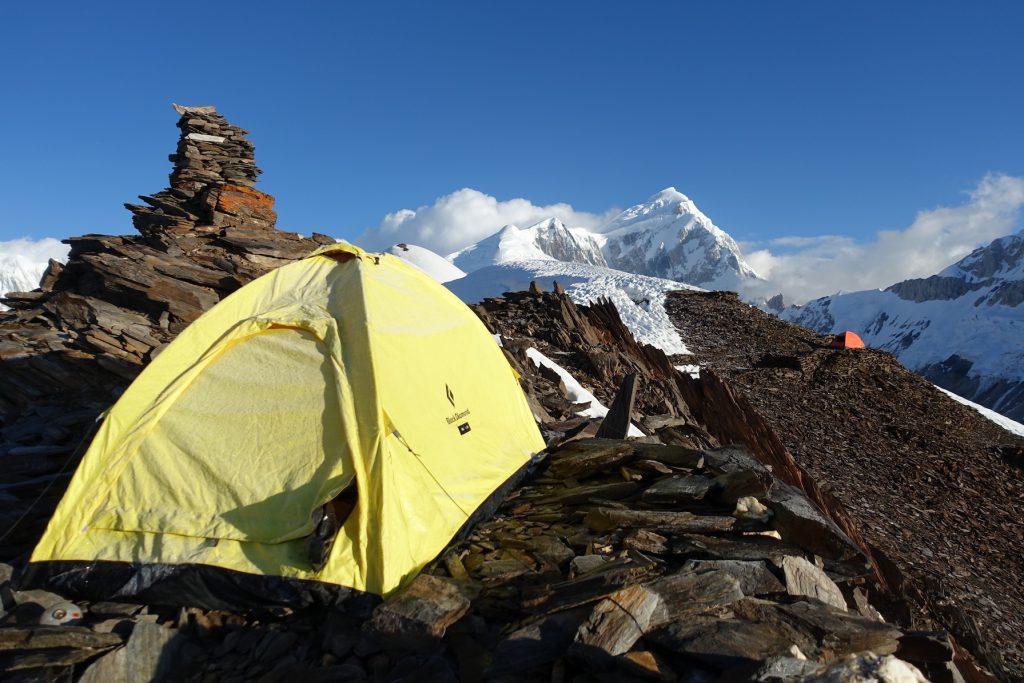[:it]
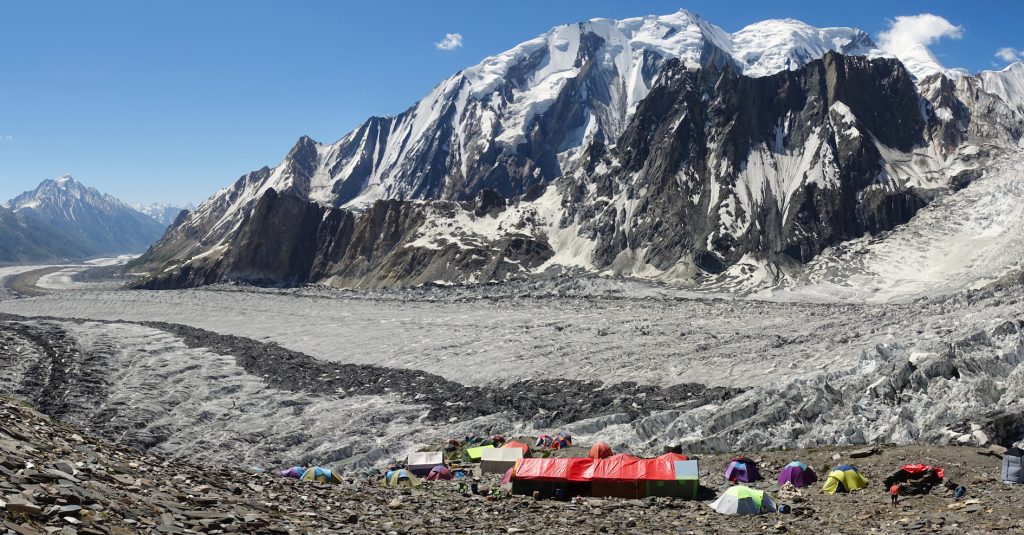
“Il meno difficile” dei 7000 ?
Nell’Agosto del 2019 ho seguito e poi letto la storia di una salita allo Spantik, una montagna di 7027mt nella Hunza Valley in Pakistan ; lo Spantik è una meta piuttosto comune per chi si approccia alle alte quote, per la sua relativa assenza di grandi difficoltà tecniche lungo la via normale, tuttavia niente affatto facile per il lunghissimo sviluppo e alcune sezioni tecniche.
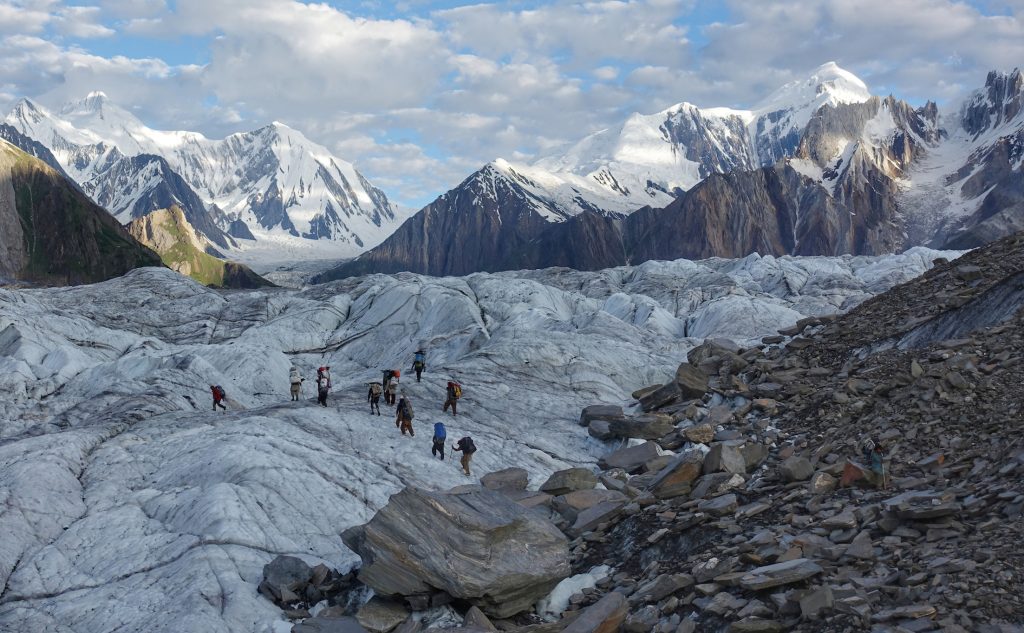 Portatori sul ghiacciaio (c) Graham Wyllie
Portatori sul ghiacciaio (c) Graham Wyllie
Se poi la via non è atttrezzata con corde fisse e traccia, come nel caso in questione, la “relativa facilità” viene del tutto meno ; i due alpinisti, infatti, affronteranno l’attacco alla vetta partendo da 5500mt su terreno completamente vergine e sconosciuto, senza corde né traccia. Per Graham, dopo una partenza fulminante e in gran forma, nel lungo attacco alla vetta, arriveranno i sintomi di mal di montagna ben conosciuti: allucinazioni e sfinimento – fortunatamente gestiti in modo eccellente e con l’aiuto della grandissima esperienza di Giampaolo, che scegliendo la tattica di salita e discesa altrettanto veloce e senza bivacchi, ha portato i due al Campo Base felicemente e senza conseguenze.
Protagonisti di questa storia sono due alpinisti di ben diversa esperienza: Graham Wyllie, 31enne e forte alpinista scozzese ma senza esperienza di alta quota e il veterano Giampaolo Corona, guida alpina Della Valle Del Primiero nelle Dolomiti ,47enne che ha scalato parecchi ottomila e altre vette importanti in Himalaya e Karakorum. Entrambi partiti in solitaria per lo Spantik, condividendo la logistica con altre spedizioni, si sono conosciuti e hanno deciso di attaccare la vetta assieme : quella che segue è la storia di questa salita scritta da Graham ; un esempio di buono stile, di una nuova amicizia e di grande perseveranza su un terreno a lui sconosciuto, con l’aiuto – comunque reciproco – di “Jumpy” Corona.
Pur non rappresentando una impresa di particolare rilevanza alpinistica, penso che questa storia racchiuda alcuni dei valori più importanti nell’alpinismo . Ringraziando Graham per l’intervista , le splendide foto e il permesso di tradurre l’articolo apparso nel suo blog l’anno scorso,e Giampaolo per la lunga chiacchierata, il suo racconto e la visione del video ancora inedito dell’impresa (di cui sopra vedete il trailer), vi auguro buona lettura.
Giampaolo Corona, il veterano
Giampaolo Corona è una Guida Alpina con un curriculum impressionante , ma si è sempre tenuto un po’ sotto “ai radar” dei grandi media.
Ha raccontato la scalata con Graham allo Spantik QUI. Durante una lunga e piacevolissima chiacchierata al telefono, credo di aver capito alcune cose fondamentali della filosofia di Giampaolo ; prima di tutto, la distinzione tra le spedizioni agli 8000 e quelle a cime più basse ma molto più tecniche : nelle prime, spesso Giampaolo parte da solo, aggregandosi per la logistica del Campo Base ad altre spedizioni commerciali, ma non utilizzando – o facendolo al minimo possibile – corde fisse né aiuto dei portatori. Scala sempre in stile alpino e leggero, in entrambi i casi. Ma sugli 8000 o sui 7000 come lo Spantik, trova generalmente in loco qualche compagno estemporaneo nella salita, e lo sceglie “molto a pelle”. La sua esperienza gli permette subito di capire se può condividere la salita. Nelle spedizioni più tecniche, invece, prepara e sceglie accuratamente il team di scalatori. Mi ha spiegato quanto sia importante per lui fare nuove amicizie, conoscere nuove persone e godersi molto il viaggio. Ma la sua preparazione è sempre accurata e approfondita. Dalla sua prima esperienza himalayana mi ha detto di essersi immerso in testi e trattati tecnici sulla preparazione per l’alta quota. Per lui è importante ottimizzare molto il tempo di acclimatamento e poi salire il più velocemente possibile, portandosi dietro lo stretto necessario.
Infatti scrive :
“Considero il mio corpo come un motore da preparare, l’attrezzatura è il mio hardware, la testa è il mio software. Hai la testa o no. Senza di essa è meglio non andarsene.
Sto cercando la semplicità, l’essenziale. La perfezione si ottiene quando non c’è più niente da togliere, non quando non c’è più niente da aggiungere. L’arrampicata veloce e leggera sembra facile, in realtà è il risultato di un enorme lavoro a monte (preparazione sia tecnica che fisica oltre che psicologica). Nulla è inventato.”
E poi spiega:
La via di salita per Spantik è lunga e complessa (cresta, zone miste, ripidi pendii di neve e ghiaccio, lunghissimo “altopiano”). Un percorso che si snoda per 8 chilometri, 2500 metri di salita. Dopo soli 8 giorni dall’arrivo al campo base, mi sentivo pronto. Avrei usato un solo punto di supporto a 5500 m di altitudine dove avevo lasciato la mia tenda e gli elementi essenziali nudi per un bivacco, saltando il classico campo 1 e 3. Mi ero imposto una volta raggiunto la cima per scendere dritto a il campo base.
Avrei persino accettato di provare ad arrampicare completamente da solo.
Per caso ho incontrato lì un giovane e forte alpinista scozzese Graham Wyllie, che era d’accordo con me su leggerezza e semplicità, quindi mi sono detto perché non provarci insieme?
Alla fine, Giampaolo si è trovato molto bene con il giovane Graham, ed è nata una vera amicizia.
Questo, per Giampaolo, è il vero valore aggiunto nel vivere un alpinismo pulito e leale.
Intervista a Graham Wyllie
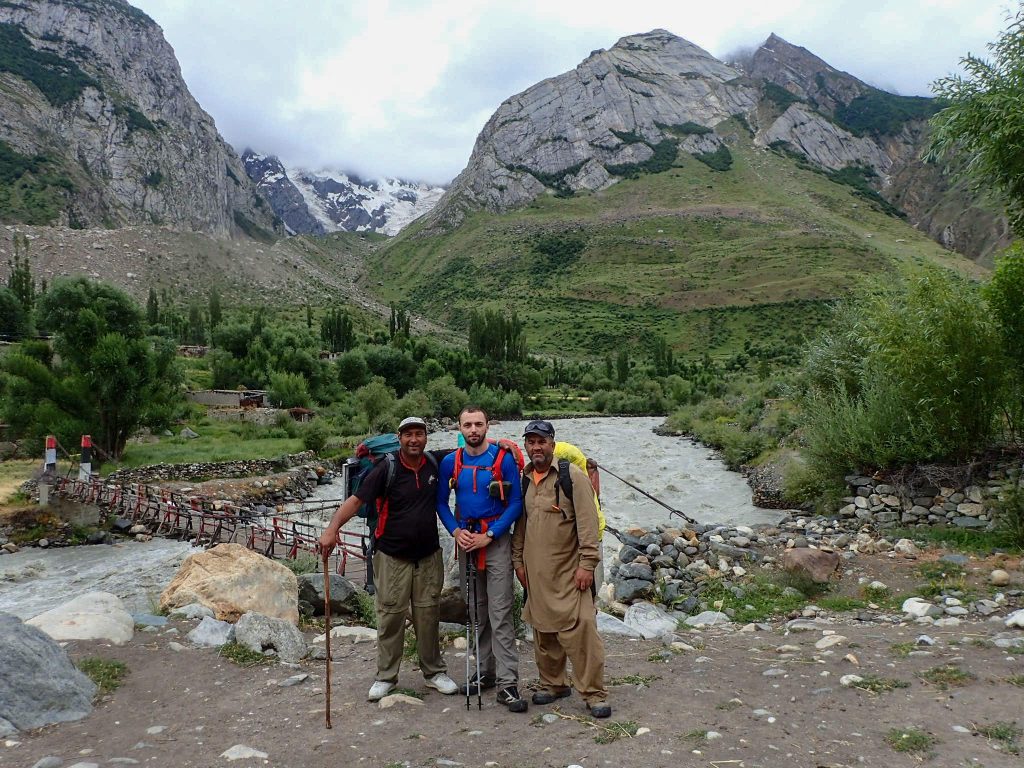 Graham Wyllie con due portatori pakistani , Arandu Bridge – avvicinamento allo Spantik
Graham Wyllie con due portatori pakistani , Arandu Bridge – avvicinamento allo Spantik
D. Questa è stata la tua prima esperienza in Karakorum/Himalaya ? Come hai organizzato la spedizione e quanto tempo hai dedicato a prepararti, logistica, attrezzature, etc ?
R.Questo è stato il mio secondo viaggio sulle grandi montagne dell’Asia. La mia prima volta è stata nel 2008, quando ho fatto parte di una squadra di 4 persone che ha tentato un picco a sud del Masherbrum chiamato Cathedral Peak (6247 m). Il tempo era brutto e abbiamo raggiunto solo poco più di 5500mt in quota. Avevo 19 anni allora, la spedizione mi ha dato una preziosa esperienza e un punto di riferimento su cui basare le mie future spedizioni. Mi ha aiutato molto per lo Spantik ,avendo molte meno incognite dal punto di vista logistico. Alcuni amici di arrampicata erano interessati al viaggio verso la fine del 2018, ma quando alla partenza nel giugno 2019 siamo rimasti in due, il sottoscritto e Andra.
Abbiamo usato la stessa agenzia locale usata nel 2008 e abbiamo acquistato solo un servizio logistico per il campo base. Questo ci ha sollevato dallo stress nell’avvicinamento alla montagna e ci siamo rilassati e concentrati sull’acclimatamento e sul godersi la bellezza impressionante dei luoghi. Avevamo una tenda, niente portatori e niente corde fisse.
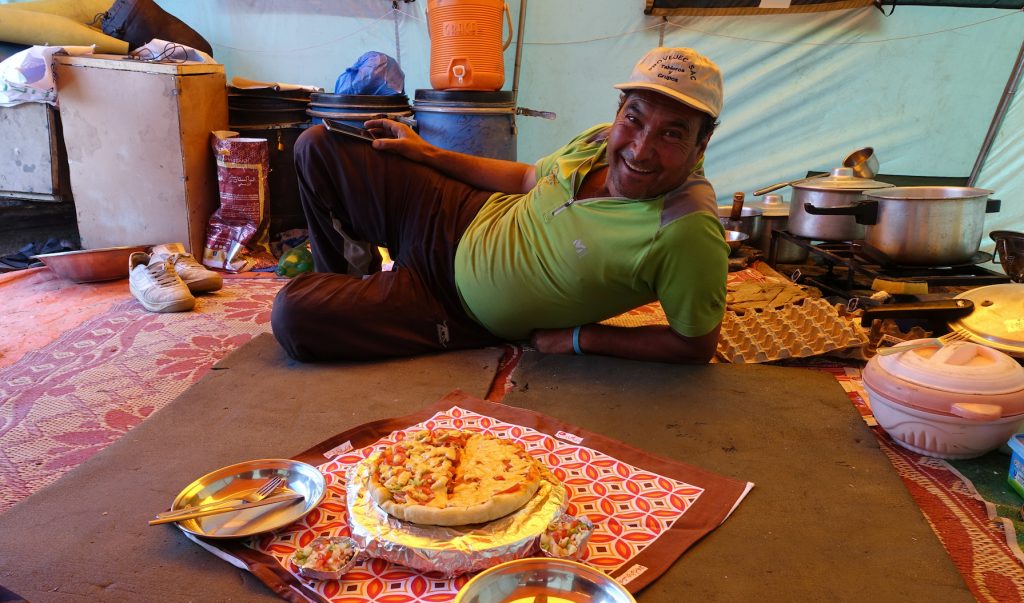 Tenda comune al BC (c) Graham Wyllie
Tenda comune al BC (c) Graham Wyllie
Abbiamo scalato il più possibile in stile alpino e avevo con me l’attrezzatura e il vestiario simile a quello che uso in Scozia in inverno. A prima vista, lo “stile alpino” dovrebbe essere leggero, ma quando si sposta una tenda, un sacco a pelo, un fornello, un cibo, ecc. non è proprio così! Per l’equipaggiamento da spedizione come radio, tenda d’altitudine, telefono satellitare, ecc., Andra è membro del Club alpino olandese (NKBV) che ci ha permesso di prendere in prestito praticamente tutto il kit specifico di cui avevamo bisogno, il che è stato fantastico.
D.Come ti sei preparato – se l’hai fatto – per l’alta quota e per questa spedizione ?
R.Per l’altitudine non ho fatto nulla di specifico prima del viaggio. Il punto più alto della Scozia è 1345 mt, quindi cercare di ottenere un po ‘di acclimatazione naturale avrebbe significato andare all’estero. Ero più concentrato sulla mia forma fisica e sui miei livelli di energia. Nell’estate del 2018 avevo lasciato il lavoro e trascorso 2 mesi nelle Alpi. Ciò, combinato con molte arrampicate invernali in Scozia, mi ha fornito una grande base specifica di fitness aerobico. Ho dovuto fare alcuni lunghi viaggi di lavoro durante la primavera, ma era un lavoro piuttosto fisico e potevo anche usare la palestra, quindi sono riuscito a rimanere abbastanza allenato. Il mese prima del viaggio ho fatto un po’ di corsa in collina e qualche arrampicata su roccia. Dopo essermi sforzato molto in inverno e poi con i viaggi con il lavoro, sono stato attento a non esaurirmi e ho puntato ad arrivare nel Karakorum ben riposato.
D.Quanti anni hai e qual’è, in breve, la tua storia con l’arrampicata e l’alpinismo ?
R. Ho 31 anni e frequento e amo le montagne dall’età di 9 anni , quando mio padre iniziò a portarmi in collina in Scozia. Durante l’ adolescenza andavamo in vacanza sulle Alpi. Vedere picchi come il Dent du Géant e il Weisshorn mi ha davvero ispirato ad arrampicarmi e acquisire le competenze necessarie per affrontare le grandi montagne europee. È stato in questo periodo che ho iniziato a leggere la letteratura alpinistica che ha aggiunto più combustibile al fuoco della passione. Alla fine del 2007 ho intrapreso la mia prima via invernale facile in Scozia e ho iniziato il lungo processo di costruzione dell’esperienza e delle conoscenze tecniche alpinistiche. Nel 2008 ho cominciato i miei primi 4000 mt sulle Alpi e ho partecipato alla mia prima spedizione extraeuropea. Ho proseguito lentamente scalando molte vie, anche sulle Alpi. Attualmente mi concentro sull’arrampicata più tecnica in Scozia, sia in estate che in inverno, e spero di potermi dedicare a obiettivi seri ed entusiasmanti sulle Alpi e sulle Catene Asiatiche nei prossimi anni.
Spantik : il racconto di Graham
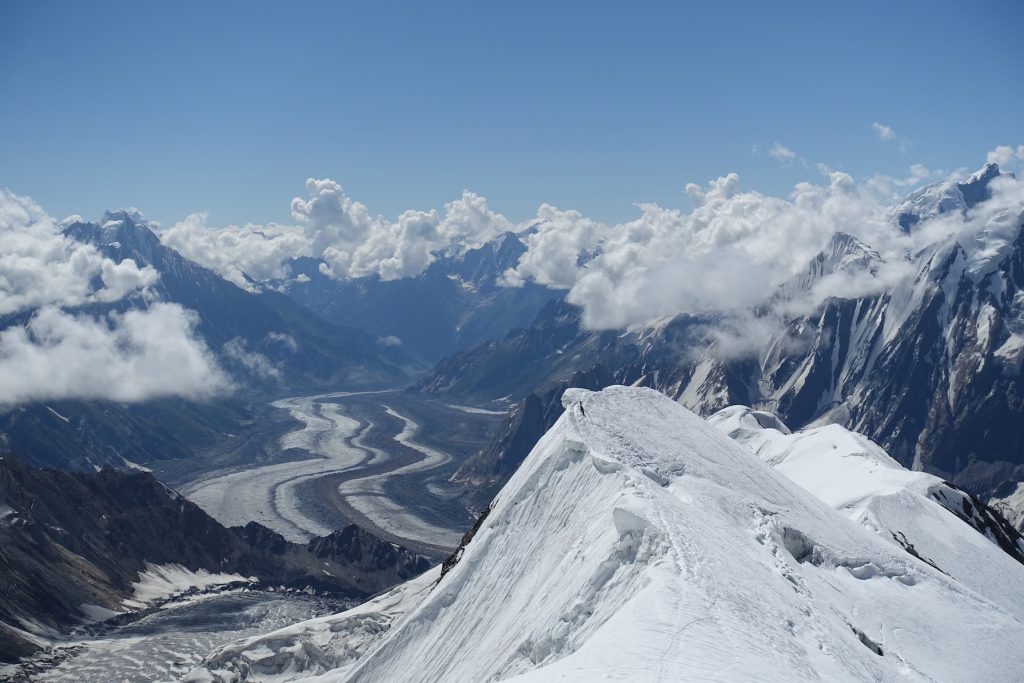 Ritorno dal C2 (c) Graham Wyllie
Ritorno dal C2 (c) Graham Wyllie
Ero più alto di quanto non fossi mai stato. Da qualche parte sopra i 6500 m sulla cresta sommitale dello Spantik. Ci sono volute tre settimane per arrivare a questo punto. Tre settimane di volo, guida, trekking, arrampicata e acclimatazione. Mi sentivo in gran forma quando abbiamo lasciato il Campo 2 a 5500 m verso le 01:30 di mattina, ma ora l’altitudine rendeva i pochi passi che stavo facendo pieni da pause e respiro pesante. I progressi erano lenti e ho avuto l’allucinazione di vedere Messner con una giacca con cappuccio davanti a me.
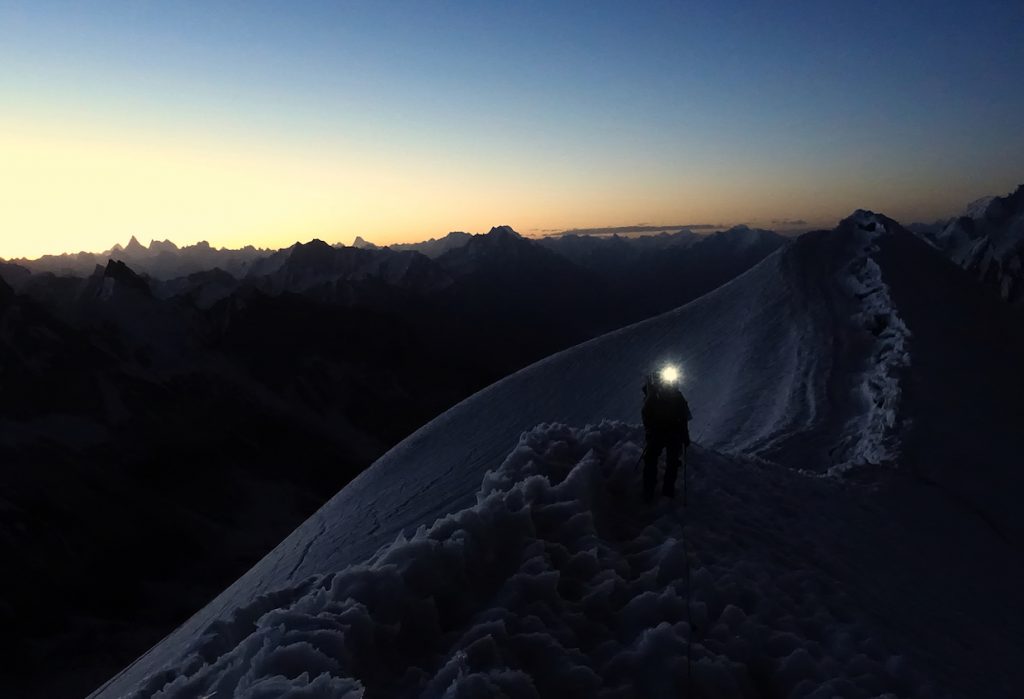 Andra sulla via C2 (c) Graham Wyllie
Andra sulla via C2 (c) Graham Wyllie
A parte il mio corpo, anche la mia mente sentiva l’altitudine, giocando brutti scherzi e inquinando la mia concentrazione con confusione e giocandosi di me. Non era Messner che vedevo ogni tanto, era “Jumpy” (“Giampi” Corona,NdR) una guida italiana delle Dolomiti.
Questo è stato il nostro primo giorno in assoluto di scalata insieme: ci siamo incontrati appena una settimana fa ma le circostanze ci hanno uniti.
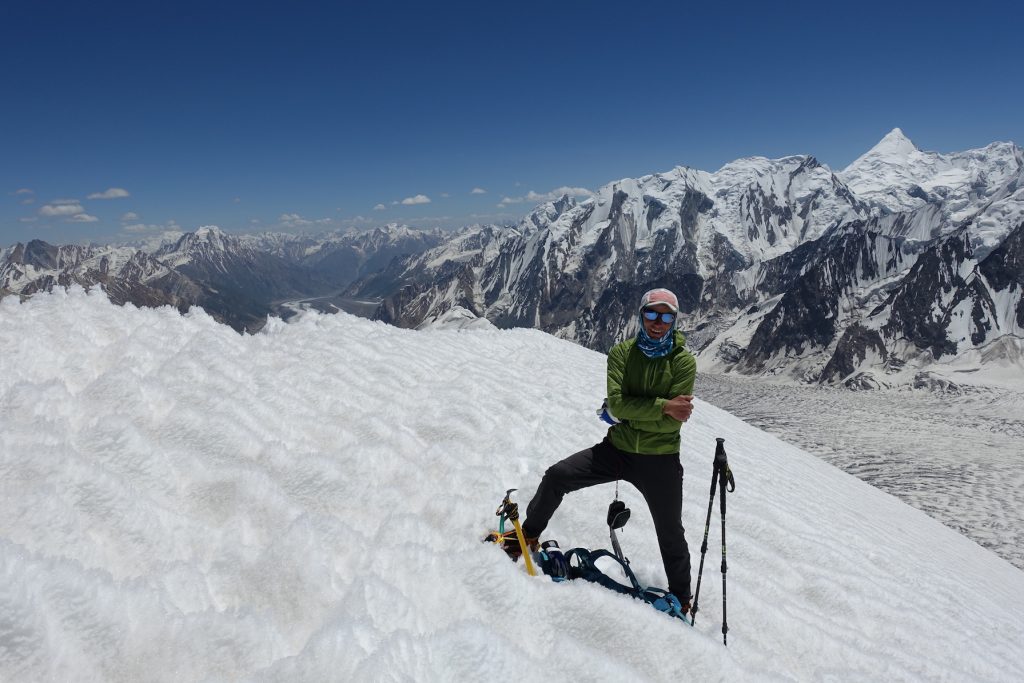 “Jumpy” Corona (c) Graham Wyllie
“Jumpy” Corona (c) Graham Wyllie
Insieme a sensazioni di de-ja-vu sentivo un’altra presenza familiare con noi, una donna anziana, forse la madre di qualcuno che seguiva la nostra scia zigzagante attraverso la neve profonda fino alla caviglia.
C’era una sezione rocciosa con neve ripida davanti. Non sembrava mai arrivare, anche se vicina. Continuavo a seguire le tracce di Jumpy, ora ero troppo indietro per fare il mio turno aprendo la pista. Se fosse stato più vicino forse gli avrei detto che sarei tornato indietro.
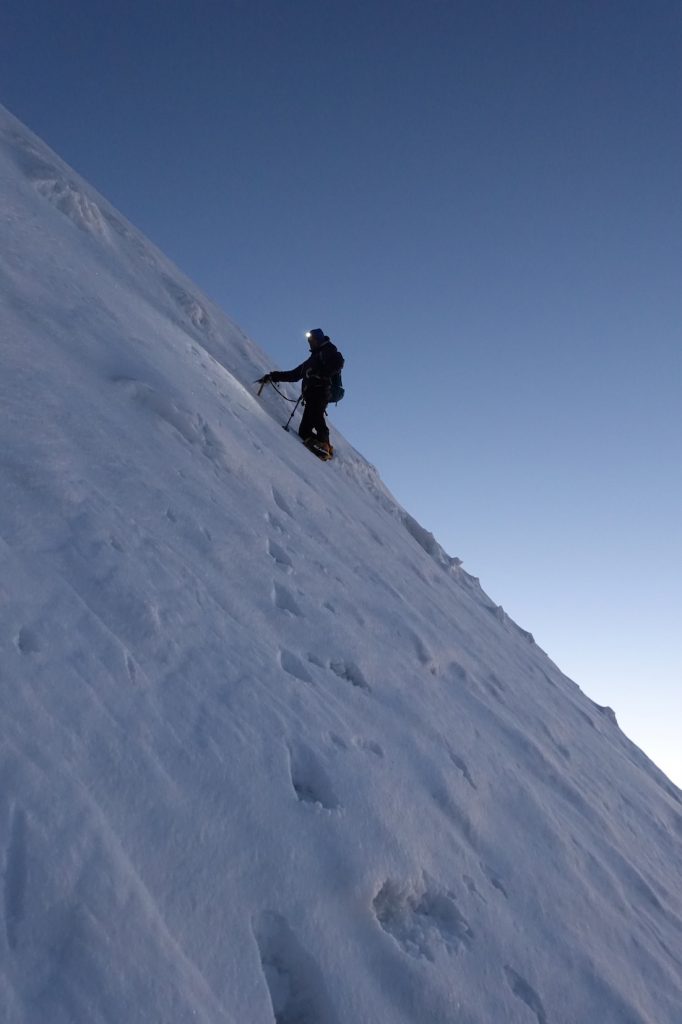 Tra C2 e C3, sezione ripida e tecnica (c) Graham Wyllie
Tra C2 e C3, sezione ripida e tecnica (c) Graham Wyllie
Passò un pò tempo con ben pochi progressi. Una lotta costante e le stesse allucinazioni. In poco tempo il vento gelido diventò un problema e ogni 5-10 minuti facevamo sosta per scaldarci le mani gelide. Piano piano, avanzammo verso lo sperone roccioso. Solo altri 20 o 30 metri di lotta poi la vetta e finalmente scendere ! Alla fine abbiamo superato la sezione ripida ma la cresta continuava verso l’alto. Ho raggiunto Jumpy. Ha detto che ci sarebbero voluti altri 50 m di altitudine. Ho provato a fare la traccia ma mi ha sorpassato.
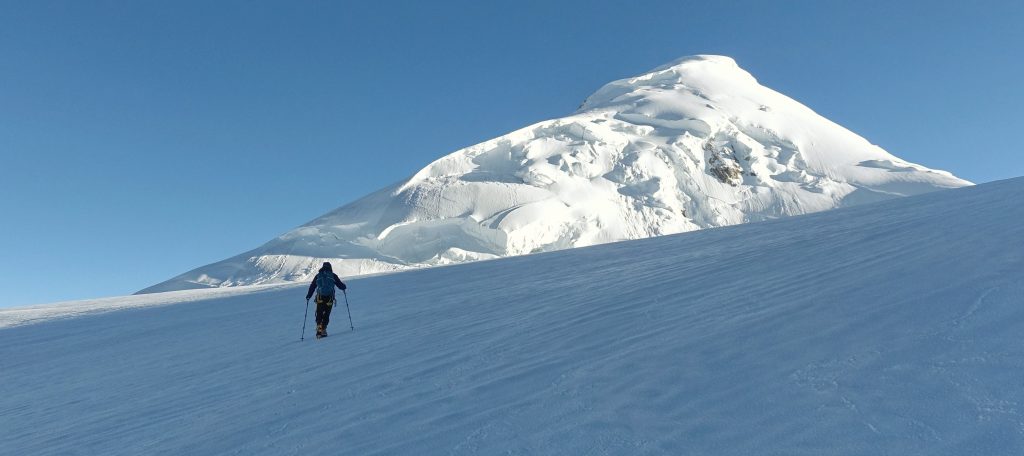 Sul plateau prima della sezione sommitale (c) Graham Wyllie
Sul plateau prima della sezione sommitale (c) Graham Wyllie
La lotta è andata avanti così ,a lungo ,poi siamo arrivati. Un nudo altopiano di neve. Ho colto finalmente il frutto di un’idea che ho avuto, in solitudine, in un bar di Canazei più di un anno fa e da allora c’è stata tutta la pianificazione, il viaggio e la spedizione, la scalata. Mi sono emozionato. La pura gioia , sperimentata ben poche volte prima di ciò : quando i sogni vengono realizzati, quando sei esattamente dove sai che dovresti essere.
Non abbiamo trascorso molto tempo in vetta, forse dieci minuti poi la discesa alle 1130 circa. La prima parte della discesa è andata bene.
Abbiamo ripercorso i nostri passi lungo la cresta e raggiunto i nostri materiali lasciati sull’altopiano. Quindi ci siamo spostati verso la cima della cresta SE e verso la via normale per il Campo 3. La sezione tra questo e il Campo 2 è il punto cruciale del percorso: Andra (l’alpinista olandese suo iniziale partner,NdR) e io avevamo vissuto un po ‘di epopea qui la settimana precedente, quando abbiamo cercato di installare il Campo 3. Per la maggior parte degli scalatori questa sezione è stata percorsa in sicurezza da corde fisse, ma nessuna squadra l’ha sistemata in quasi un mese ,lasciandola ora incompleta e tratti pericolosi. Arrampicarsi in buone condizioni è facile, arrampicarsi mentre si è esausti e dopo che il sole di mezzogiorno ha reclamato il suo pedaggio sullo stato del ghiaccio è una questione diversa.
Jumpy proseguiva. Non poteva fare molto per me. Procedevo metodicamente in avanti lungo il ripido ghiaccio zuccherino , fermandomi spesso per le pause. Ho accarezzato l’idea di fare un abalakov in corda doppia ma non era una soluzione pratica, avrebbe significato estrarre e srotolare la corda, che era ancora stivata nel mio sacco da tutto il giorno. Alla fine ho raggiunto un terreno più facile oltre un bergschund e ho fatto rapidi progressi lungo un pendio nevoso, quindi ho raggiunto lo sperone roccioso che corre per circa 100 metri al centro della parete. Passato questo punto, la metà inferiore della parete è più ghiacciata, sebbene meno ripido rispetto alla sezione più in alto. Senza stanchezza normalmente avrei fatto un rapido lavoro su questo terreno nonostante le sue pessime condizioni. Ma in questa giornata è andata diversamente. Avanzai affrontando il pendio e lottando costantemente per il mio equilibrio d’appoggio. La prima sezione è andata bene. Partendo dalla sezione successiva i miei ramponi hanno ceduto e ho iniziato a scivolare giù per il pendio. Dopo 10-15 m con una manovra d’arresto con piccozza mi sono fermato con una piccola valanga di ghiaccio zuccherino che scorreva intorno a me. Ho puntato rapido verso il resto del pendio.
Il resto della via fino a campo 2 è trascorso senza ulteriori incidenti. Qualche crepaccio ma ovvio e facile da attraversare o da evitare. L’unico altro problema era la neve. Resa molle dal caldo del sole era una tortura. Non importa, mi dissi, presto sarei potuto felicemente crollare nella mia tenda al campo 2. Verso le 16:30, quando arrivai, Jumpy aveva già smontato la sua tenda e mi stava aspettando. Mi informò del maltempo in arrivo e che quindi dovevamo scendere direttamente al campo base. Era l’ultima cosa che volevo sentire, ma aveva ragione e restare non era proprio un’opzione. Ho fatto i bagagli, messo le attrezzature per cucinare e dormire da parte e mi sono trovato con uno zaino piuttosto pesante.
Ormai conoscevo bene la via dal campo 2. Andra e io avevamo viaggiato alcune volte nei nostri sforzi per acclimatarci e prepararci per il nostro tentativo di vertice. Tra il campo 2 a 5500 mt il campo 1 a 5050 m il percorso è una dorsale ondulata di neve lunga quattro chilometri. È abbastanza esposta e scenica in alcuni punti. Ci sono crepacci e cornici occasionali ma nulla di eccessivamente serio. Il problema principale quando si scende a questo orario è la condizione della neve. Jumpy proseguiva. Mi teneva d’occhio per assicurarsi che stessi proseguendo – ma non aveva senso che entrambi andassimo al mio ritmo, metodico ed esausto. A volte mentre sprofondavo sulle mie ginocchia nella neve capivo che eravamo vicini e mi sentivo un po ‘meglio.
Alla fine sono arrivato al primo campo e si stava facendo buio, quindi ho indossato la torcia frontale. Ho iniziato a sentirmi un po ‘meglio e sono riuscito a muovermi un po’ più velocemente. Forse questo era l’effetto benefico della bassa quota c o il fatto che il percorso da qui fosse praticamente in discesa. Il percorso fino al campo base da qui è stato buono. Era ripido in alcuni punti ma ben segnalato e privo di neve ; costituito principalmente da terra, ghiaia e roccia frantumata anche se abbastanza stabile. Vidi due luci che si avvicivano. Era Andra ad accoglierci e congratularsi, assieme a un emotivo Paco (il nostro cuoco / riparatore locale), che è emerso dall’oscurità e mi ha abbracciato. Penso di non aver mai incontrato una persona più felice a vedermi! Mi ha preso il sacco per le restanti poche centinaia di metri al campo base arrivando poco dopo il 21:00, dove siamo stati accolti dalla spedizione catalana, dai cuochi di Jagged Globe e da altri portatori che si congratularono con noi.
Alla fine sono molto soddisfatto dello stile della mia salita. Una lunga spinta dal campo 2 in vetta non sarebbe stata facile, soprattutto per tornare in BC lo stesso giorno. Con il senno di poi, io e Andra siamo riusciti a stabilire il campo 3, quindi credo che avremmo comunque fatto vetta insieme. Questo, tuttavia, ci avrebbe costretto a rimanere bloccati al campo 3 per un fine settimana di maltempo. Una lunga spinta dal campo 2 è diventata l’unica opzione dato il tempo che ci restava e questo non è stato certamente il modo più semplice per scalare lo Spantik. La mancanza di corde fisse significava anche che il rischio di una difficile discesa fino al campo 2 dall’altopiano, quando i livelli di energia erano bassi, e doveva essere attentamente valutata nella sua fattibilità. Sia per Jumpy, che ha una notevole esperienza sulle vette di 8000 m, sia per me lo Spantik è stato più duro di quanto la sua reputazione suggerisca. Ciò può essere riconducibile alla lunga scalata in stile alpino che è stata la nostra ascesa ; ho comunque percepito che non è certo una montagna da sottovalutare. Si tratta di una vetta di 7000 m con un lungo percorso e passaggi tecnici soggetti al clima e alle condizioni del Karakorum.
Ci vuole un sacco di tempo e fatica per scalare picchi di questa scala. Ci sono volute 4 settimane di viaggio, trekking, acclimatazione e arrampicata e questo solo per avere una possibilità in vetta , senza includere la preparazione prima del viaggio per logistica, kit, permessi e visti. Il modo in cui si fa acclimatazione, il rimanere in salute ed essere abbastanza in forma sono tutti fattori decisivi e, naturalmente, si collegano al livello di rischio che si è disposti a correre in un ambiente ostile. Il tempo ha sempre voce in capitolo e puoi facilmente passare giorni seduti al campo aspettando che cambi, come ho fatto in una precedente spedizione senza successo a una vetta della zona. La metà del nostro tempo passato sullo Spantik è stata spesa riposando o aspettando le finestre di bel tempo al campo base. Anche il viaggio stesso, vale a dire i luoghi e le persone incontrate, devono essere fattori apprezzati perché se tutto fosse vissuto come “un intermezzo” per arrivare in cima, il viaggio risulterebbe assai deludente !
[:en]
 Spantik Base Camp (c) Graham Wyllie
Spantik Base Camp (c) Graham Wyllie
“Least difficult” 7000ers ?
In August 2019 I followed and then read the story of a climb to Spantik, a 7027mt mountain in the Hunza Valley in Pakistan; Spantik is a rather common destination for those approaching high altitudes, due to its relative absence of great technical difficulties along the normal route, however not at all easy for the very long development and some technical sections.
 Porters on Glacier (c) Graham Wyllie
Porters on Glacier (c) Graham Wyllie
If the route is not equipped with fixed ropes and tracks, as in the case in question, the “relative ease” become another affair; in fact, the two climbers will face the bid to the summit starting from 5500mt on completely virgin and unknown terrain, without ropes or tracks. For Graham, after a brilliant start of the climb, the long attack on the summit cost him the first experience of typical symptoms of altitude sickness : hallucinations and exhaustion – fortunately managed in an excellent way and with the help of the great experience of Giampaolo, who chose the fast ascent as both the descent tactic ,without bivouacs , which led the pair to Base Camp happily and without any health consequences.
The protagonists of this story are two mountaineers with very different experience: Graham Wyllie, a young and strong Scottish mountaineer without high altitude experience and the veteran Giampaolo Corona, 47-year-old mountain guide of the Dolomites who has climbed several eight thousand and other important peaks in the Himalaya and Karakorum. Both left alone for Spantik, sharing the logistics with other expeditions, they met and decided to attack the summit together: what follows is the story of this climb written by Graham; an example of good style, of a new friendship and of great perseverance on a terrain unknown to him, with the help – however mutual – of the great experience of “Jumpy” Corona.
While not representing a particular mountaineering relevance, I think this story contains some of the most important values in mountaineering. Thanks to Graham (and Giampaolo, who told his version HERE) for permission to translate the article that appeared on his blog, I wish you a good read.
Giampaolo Corona, the Veteran
Giampaolo Corona is an Alpine Guide with an impressive curriculum, but he has always kept a little under the radar of the big media.
He recounted the climb with Graham to Spantik HERE. During a long and very pleasant chat on the phone, I believe I understood some fundamental things of Giampaolo’s philosophy; first of all, the distinction he made between expedition at “normal” 7/8000rs and lower peaks but much more technical: in the first case, often Giampaolo starts alone, joining the logistics of Base Camp with another commercial expedition, but not using – or doing it at minimum possible – fixed ropes and no porters help. Always climbing in alpine and light style, in both cases. But on the 8000 or 7000 like the Spantik, he generally finds new partners in the climb on the spot, and chooses them with his insightful and inner feeling . His experience allows him to immediately understand if he can share the climb with someone else. In more technical expeditions, on the other hand, he prepares and carefully chooses the team of climbers. He explained how important it is for him to make new friends, meet new people and enjoy the trip a lot. But its preparation is always accurate and thorough. From his first Himalayan experience he told me that he had immersed himself in technical texts and treatises on preparing for high altitude. It is important for him to optimize the acclimatization time very much and then go up as quickly as possible, taking with him the bare minimum.
In fact he writes:
“I consider my body as an engine to prepare, the equipment is my hardware, the head is my software. You have the head or not. Without it it is better not to leave.
I am looking for simplicity, the essential. Perfection is achieved when there is nothing more to remove, not when there is nothing more to add. Fast and light climbing seems easy, in reality it is the result of a huge upstream work (both technical and physical as well as psychological preparation). Nothing is invented. “
And then he explains:
The way up to Spantik is long and complex (ridge, mixed areas, steep slopes of snow and ice, very long “plateau”). A path that winds for 8 kilometers, 2500 meters of ascent. After only 8 days from arriving at base camp, I felt ready. I would have used only one support point at 5500 m above sea level where I had left my tent and bare essentials for a bivouac, skipping the classic camp 1 and 3. I had imposed myself once I reached the top to go straight to the base camp .
I would even have agreed to try climbing completely on my own.
By chance I met a young and strong Scottish mountaineer Graham Wyllie there, who agreed with me on lightness and simplicity, so I said why not try it together?
In the end, Giampaolo got on very well with young Graham, and a real friendship was born.
This, for Giampaolo, is the real added value in living a light,clean and fair mountaineering.
Interview : Graham Wyllie
 Graham Wyllie with two pakistani porters , Arandu Bridge – on the way to Spantik
Graham Wyllie with two pakistani porters , Arandu Bridge – on the way to Spantik
A.This was my second trip to the Greater ranges. My first was back in 2008 when I was part of a team of 4 that attempted a peak to the south of Masherbrum called Cathedral peak (6247m). The weather was poor and we only reached a little over 5500m. I was 19 at the time and It gave me valuable experience and a reference point to base future trips on. This helped a lot with the Spantik trip as there were far less unknowns on the logistical side of things. I had a few of my climbing partners interested in the trip in Late 2018 but by the time we went in June 2019 there were just two, Andra and myself.
We used the same local tour company as I did in 2008 and took only a base camp service. This takes a lot of stress out of the approach to the mountain and you can relax a bit and focus on acclimatising and taking in the impressive surroundings. Above base camp things are simple. We had one tent, no porters and no fixed ropes.
 Mess Tent at BC (c) Graham Wyllie
Mess Tent at BC (c) Graham Wyllie
We climbed as alpine style as we could and I had similar clothing with me that I would use in Scotland in the winter. At a glance ‘Alpine Style’ sounds like it should be lightweight but when you are moving a tent, Sleeping bag, stove, food, etc It doesn’t work out like that! For expedition gear like Radios, Sat phone HA tent, etc, Andra is a member of the Dutch Alpine Club (NKBV) and they let us borrow pretty much all the specific kit we needed which was fantastic.
Q. How did you prepare to high altitude before the trip, if you did it?
A.For the altitude I did nothing specific before the trip. The highest point in Scotland is 1345m so trying to get some natural acclimatization beforehand would have meant going abroad. I was more focused on fitness and my energy levels. I had quit my job at the beginning of the summer of 2018 and spent 2 months in the Alps. This combined with a lot of winter climbing in Scotland inadvertently provided me with a large specific base of aerobic fitness. I had to do some long trips away with work during the spring but It was quite physical work and I could also use the gym so I managed to stay pretty well conditioned. The month before the trip I did a small volume of hill running and some rock climbing. After pushing myself a lot in the winter and then the trips with work, I was careful not to exhaust myself and aimed to arrive in the Karakorum well rested.
Q. How old are you, and can you tell me briefly about your climbing history?
A. I’m 31 and have been enjoying the mountains since I was 9 when my father started taking me hillwalking in Scotland. I stuck with it and by my mid-teens we were going on Walking holidays to the Alps. Seeing peaks like the Dent du Géant and the Weisshorn really inspired me to get into climbing and gain the skills necessary to go to those high places. It was around this time I started reading mountaineering literature as well which added more fuel to the fire. In late 2007 I got taken up my first easy winter route in Scotland and began the long process of building experience and technical knowledge. In 2008 I summitted my first 4000m peaks in the Alps and also went on my first expedition. In the years since I have slowly worked my way up the grades and climbed also a lot in the Alps. For now I am focused on more technical climbing in Scotland both in summer and winter and hopefully I can transition this to exciting objectives in the Alps and Greater Ranges in the coming years.
Spantik: Graham’s Story
 Ritorno dal C2 (c) Graham Wyllie
Ritorno dal C2 (c) Graham Wyllie
I was higher than I had ever been. Somewhere above 6500m on Spantik’s Summit ridge. It had taken three weeks to get here. Three weeks of flying, driving, trekking, climbing and acclimatising. I had felt strong since we left Camp 2 at 5500m at around 0130 but now the altitude meant that the few steps I was taking were backed up by rests and heavy breathing. Progress was slow and I could see Messner in his hooded down jacket ahead of me.
 Andra sulla via C2 (c) Graham Wyllie
Andra sulla via C2 (c) Graham Wyllie
Aside from my body my mind was feeling the altitude too, playing tricks on me and polluting my concentration with confusion and playful misinformation. It was not Messner I reminded myself every so often, It was ‘Jumpy’ an Italian Guide from the Dolomites.
This was our first ever day climbing together, we’d met barely a week ago but circumstances had brought us together.
 “Jumpy” Corona (c) Graham Wyllie
“Jumpy” Corona (c) Graham Wyllie
Along with instances of de-ja-vu I felt another familiar presence with us, an old woman, perhaps somebody’s mother approving of our zig zagging trail through the ankle deep snow. There was a rocky section with steep snow ahead. It didn’t seem to be getting closer. I kept following Jumpy’s tracks, I was now too far behind to take my turn breaking trail. If he had been closer perhaps I would have told him I was going back.
 Tra C2 e C3, sezione ripida e tecnica (c) Graham Wyllie
Tra C2 e C3, sezione ripida e tecnica (c) Graham Wyllie
Some time went by with little progress. A constant struggle and the same hallucinations. Before long the icy wind provided us with a new problem and every 5-10 mins we stopped to warm our freezing hands. As time raced by we inched towards the rocky outcrop. This must be it. Just another 20 or 30m of struggle then the summit and we could go down. Eventually we surmounted the the steep section but the ridge continued upwards. I caught up with Jumpy. He said another 50m altitude to go. I tried to break trail but he overtook me.
 Sul plateau prima della sezione sommitale (c) Graham Wyllie
Sul plateau prima della sezione sommitale (c) Graham Wyllie
The struggle went on for so long and then we arrived. A bare plateau of snow. The fruits of an idea I had while alone in a Canazei bar over a year ago and all the planning, travelling and climbing since. I felt emotional. The pure joy that I’ve only experianced a few times before, when dreams are realised, when I am exactly where I know I should be.
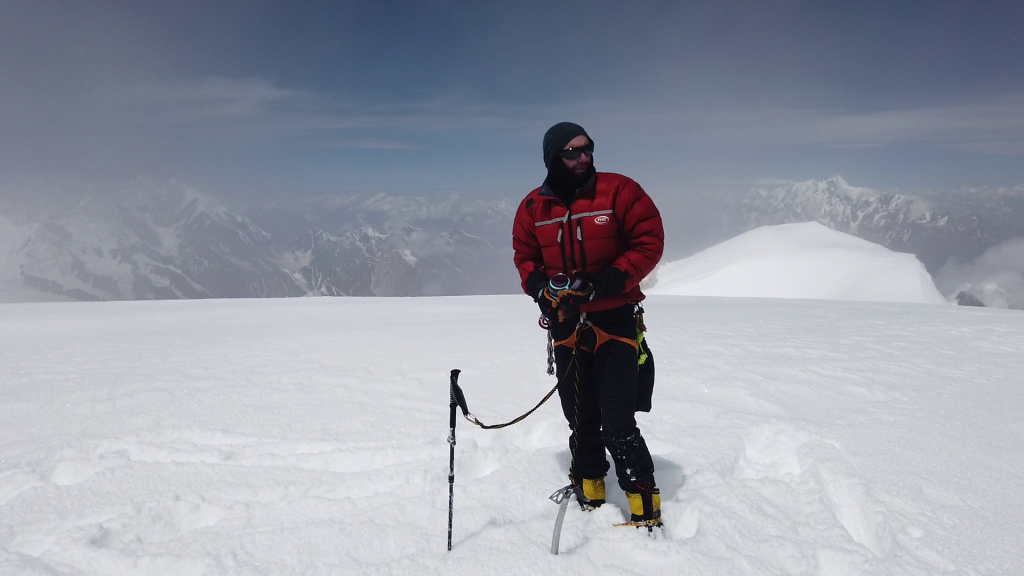 Graham on summit (c) Graham Wyllie, ph Giampaolo Corona
Graham on summit (c) Graham Wyllie, ph Giampaolo Corona
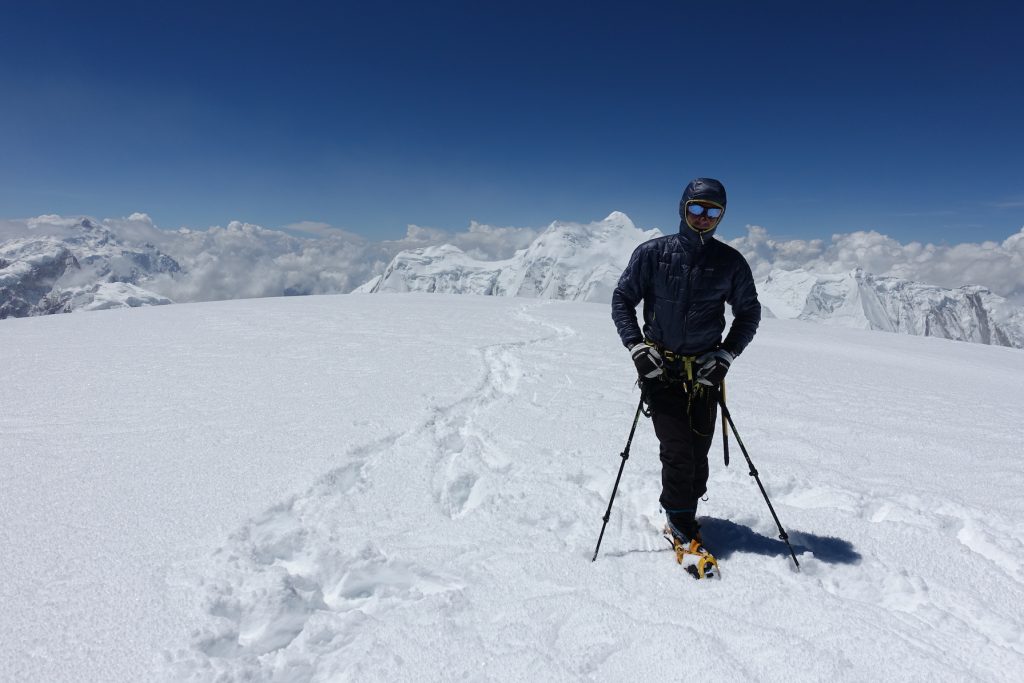 Giampaolo on summit (c) Graham Wyllie
Giampaolo on summit (c) Graham Wyllie
We didn’t spend long there, maybe ten minutes leaving to start the descent at 1130. The first part of the descent went well. We retraced our steps down the ridge and reached our bags on the plateau. Then we moved towards the top of the SE ridge and the normal site for Camp 3. The section between this and Camp 2 is the technical crux of the route. Andra and myself had had a bit of an epic here the following week when we tried to establish Camp 3. For most climbers this section is made safe by fixed ropes but no team had fixed it in almost a month leaving them now in an incomplete and dangerous state. Free climbing this upwards in good conditions is easy, downclimbing this while exhausted and after the midday sun has taken it’s toll on the ice is a different matter.
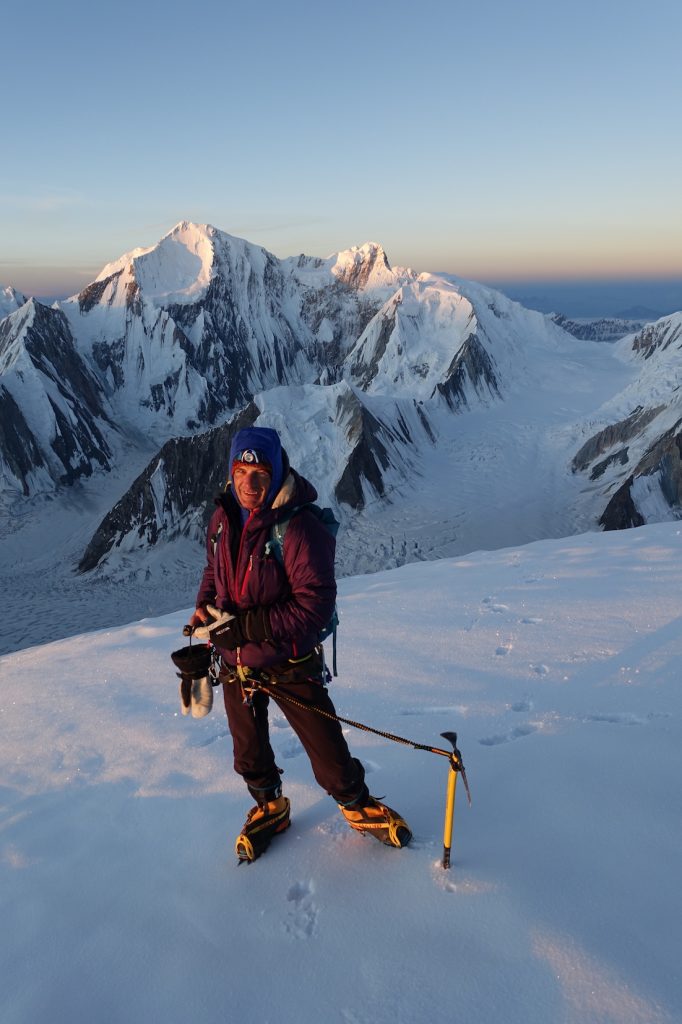 Giampaolo, near C3 (c) Graham Wyllie
Giampaolo, near C3 (c) Graham Wyllie
Jumpy went on down. There wasn’t much he could do for me. I methodically front pointed my way down the steep sugary ice stopping often for breaks. I toyed with the idea of making an abolocov to abseil but it wasn’t practical. It would have justified carrying the rope though, it was still coiled in my sack as we had solo’d together all day. Eventually I reached easier ground beyond a bergshund and made quick progress down a snow slope then the rocky spur that runs for about 100m down the centre of the face. Beyond this the lower half of the face is more sugary ice albeit at a less serious angle than higher up. Without exhaustion I would normally make quick work of this terrain despite its poor condition. Today was different. I advanced facing down the slope and constantly struggled for my footing. The first section went ok. Starting down the next section my crampons gave way and I began to slide down the slope. After 10-15m my ice axe arrest held and I came to a halt with an avalanche of sugary ice flowing around me. I front pointed down the rest of the slope.
The rest of the journey to camp 2 was without further incident. There are crevasses but they are obvious and easy to cross or avoid. The only other issue was the snow. Now softened by the heat of the day it was torturous. Nevermind I told myself, soon I could blissfully collapse in my tent at camp 2. At around 1630 when I arrived Jumpy had packed his tent away and was waiting for me. He informed me of incoming bad weather and that I needed to go down to base camp too. It was the last thing I wanted to hear but he was right and staying wasn’t really an option. I packed up the tent, cooking and sleeping equipment and ended up with quite a hefty sack.
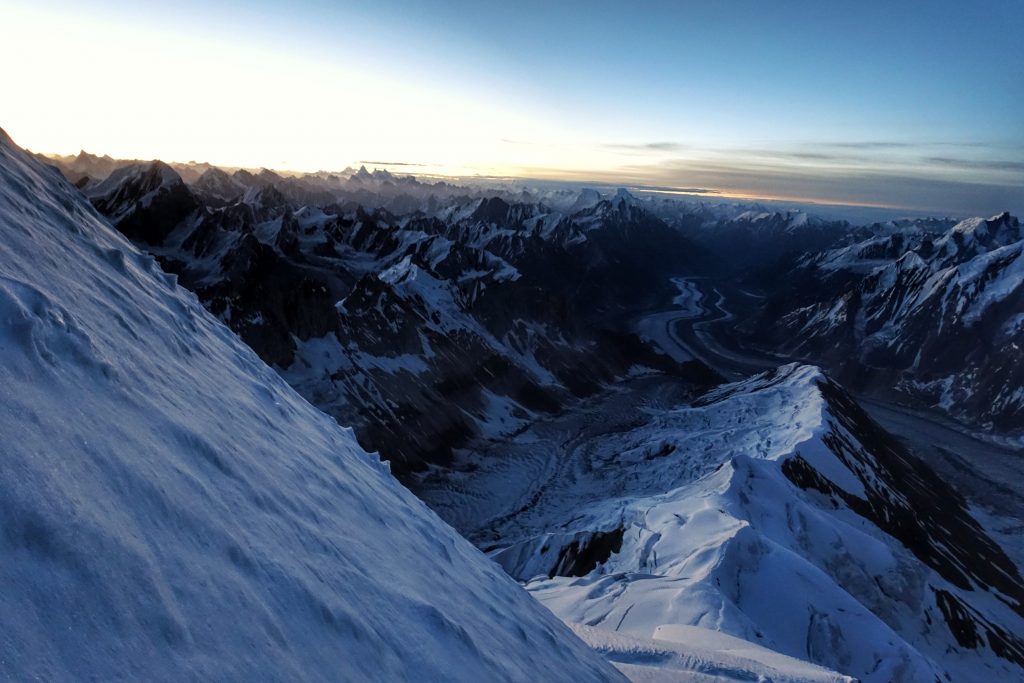 Going down on SE ridge (c) Graham Wyllie
Going down on SE ridge (c) Graham Wyllie
I knew the route down from camp 2 well by now. Andra [initial partner and holland climber,NdR]and myself had travelled it a few times in our efforts to acclimatise and prepare for our summit attempt. Between camp 2 at 5500m and camp 1 at 5050m the route is an undulating snow ridge four kilometres long. It’s quite exposed and scenic in places. There are occasional crevasses and cornices but nothing overly serious. The main issue with travelling down at this time is the condition of the snow. Jumpy went on ahead. He kept an eye backwards to make sure I was progressing but there was no point in us both going at my exhausted methodical pace. Sometimes while sinking over my knees into the snow the familiar old woman was there. She knew about the deep snow and she made me feel a bit better about it.
Eventually I arrived into camp one and it was getting dark so I put my headtorch on. I began to feel a bit better and was able to move a little faster. Perhaps this was the lower altitude catching up with me or the fact that the route from here is pretty much completely downhill. The path down to base camp from here is good. It is steep in places but it’s well marked and snow free consisting mainly of dirt, scree and shattered although somewhat stable rock. About two thirds of the way down a headtorch grew close. It was Andra who offered her congratulations. An emotional Paco, our cook/local guide/fixer, emerged from the darkness and gave me a hug. The happiest anyone has ever been to see me I think! He carried my sack the remaining few hundred meters to base camp arriving sometime after 2100 where I was met by the Catalan expedition and Jagged globe’s cooks and HAP’s who congratulated me also.
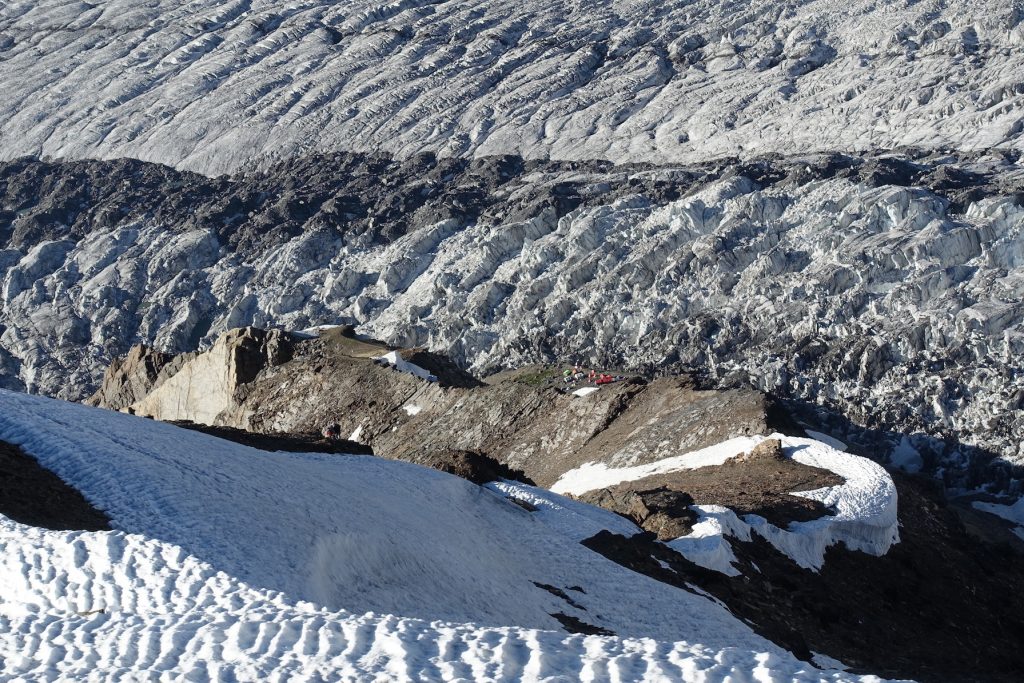 Base Camp as seen from C1 (c) Graham Wyllie
Base Camp as seen from C1 (c) Graham Wyllie
In the end I am very pleased with the style of my ascent. A long push from camp 2 was never going to be easy especially to come back down to BC the same day. In hindsight had me and Andra managed to establish camp 3 then I believe we would have summited together. This would however have left us stuck at camp 3 through a weekend of bad weather. A long push from camp 2 became the only option given the time we had left and this is certainly not the easy way. The lack of fixed ropes also meant that risk on the serious descent down to camp 2 from the plateau when energy levels are low had to be carefully considered. Both Jumpy, who has considerable experience on 8000m peaks, and myself felt that Spantik was harder than it’s reputation suggests. This may have been down to the long alpine style nature of our ascent but even still I felt that it was not a peak that should be underestimated. It is a 7000m peak with a long route and technical passages that is subject to Karakorum weather and conditions.
Its a lot of time and effort to climb peaks of this scale. It has taken 4 weeks of travelling, trekking, acclimatising and climbing and that is just to have a chance at the summit and does not include preparation before the trip of logistics, kit, permits and visas. How well you acclimatise, staying healthy and being fit enough all are decisive factors and of course tie in with the level of risk you are prepared to take in a hostile environment. The weather always has it’s say and you can easily spend days sitting in Camp waiting for it to change as I did on a previous unsuccessful expedition to a different peak in the range. Even with success about half of our time on Spantik was spent resting or waiting for weather at base camp. The journey itself, namely the places and the people encountered are also to be appreciated because if it is all viewed as a means to a summit then it’s going to be a long and potentially disappointing trip.
[:]
